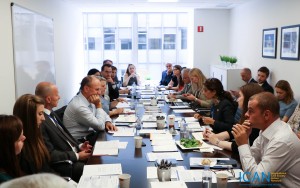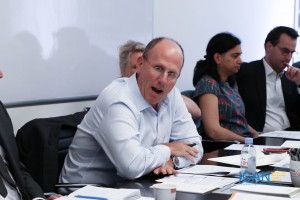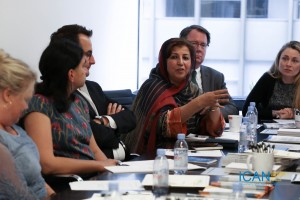 On Tuesday, September 24, 2019, ICAN and the Prevention Project co-hosted “Two Sides of the Same Coin? Operationalizing Linkages Between the SDG 16 and PVE Agendas,” a side event to the 74th session of the UN General Assembly. The event, held at the Global Center on Cooperative Security, expanded on a discussion during the UN High-Level Political Forum in July 2019 that explored the linkage between UN Sustainable Development Goal 16 (peaceful and inclusive societies) and the preventing violent extremism (PVE) agenda. It also introduced “The SDG 16 and PVE Agendas: Different Currencies or Two Sides of the Same Coin?”, a brief that examines the challenges related to the siloed approaches, why it is important to integrate the two agendas, and proposes a way forward. It contains 14 concrete, practical recommendations for the global community, national actors, donors, and assessments/analysis. It is available here.
On Tuesday, September 24, 2019, ICAN and the Prevention Project co-hosted “Two Sides of the Same Coin? Operationalizing Linkages Between the SDG 16 and PVE Agendas,” a side event to the 74th session of the UN General Assembly. The event, held at the Global Center on Cooperative Security, expanded on a discussion during the UN High-Level Political Forum in July 2019 that explored the linkage between UN Sustainable Development Goal 16 (peaceful and inclusive societies) and the preventing violent extremism (PVE) agenda. It also introduced “The SDG 16 and PVE Agendas: Different Currencies or Two Sides of the Same Coin?”, a brief that examines the challenges related to the siloed approaches, why it is important to integrate the two agendas, and proposes a way forward. It contains 14 concrete, practical recommendations for the global community, national actors, donors, and assessments/analysis. It is available here.
The event brought together representatives of member states, international organizations, and civil society to highlight ways in which efforts aimed to support SDG 16 and those that target violent extremism are mutually reinforcing in their shared aims to promote peace, justice, resilience, and inclusion.
 Rafia Bulai, Senior Programs Officer at Global Center, opened the roundtable by welcoming participants and introducing the topic at hand. She emphasized the need to understand the underlying issues that contribute to recruitment to violent extremism, the importance of economic empowerment and equality, and the necessity for governance accountability.
Rafia Bulai, Senior Programs Officer at Global Center, opened the roundtable by welcoming participants and introducing the topic at hand. She emphasized the need to understand the underlying issues that contribute to recruitment to violent extremism, the importance of economic empowerment and equality, and the necessity for governance accountability.
Sanam Naraghi Anderlini, Founder and Executive Director of ICAN, gave an overview of the July meeting. She underscored that keeping the agendas siloed is getting in the way of good work. The distinctions that exist at the national and international levels do not exist on the ground; things go hand-in-hand.
Naraghi Anderlini also noted that violent extremism is a specific type of violence, and thus should not be grouped with other types of violence. Instead, the international community must acknowledge that people on the ground are dealing with certain realities.
“Teaching isn’t just telling teachers to watch for signs of radicalization; it’s teaching pluralism, teaching history in a different, more inclusive, way.”
– Sanam Naraghi Anderlini, ICAN
 Eric Rosand, Director of Prevention Project, discussed the recommendations that were developed during the July 2019 event, and the integrated approach to the PVE and SDG 16 agendas at the national and international levels that they provide. Rosand moderated the discussion that followed.
Eric Rosand, Director of Prevention Project, discussed the recommendations that were developed during the July 2019 event, and the integrated approach to the PVE and SDG 16 agendas at the national and international levels that they provide. Rosand moderated the discussion that followed.
Lucy Turner, with UNDP’s Bureau of Policy and Programme Support, argued that it is not simply about integrating the PVE and SDG 16 agendas, but also developing new ways to build peace around the world. To do this, we must be creative. There must be national ownership and participation in implementing activities, including opportunities for people to speak and be heard. She noted that people don’t exist in silos.
Khalid Koser, Executive Director of GCERF, put forth three points. First, concrete examples from the ground of how PVE and SDG 16 overlap are hard to find because they are so similar—you have to discern how they are separate. Second, PVE work can also be linked with other SDGs, not just SDG 16, such as SDG 1 (no poverty) and SDG 4 (quality education). Finally, the PVE and SDG 16 agendas are indeed two sides of the same coin on the ground. However, as you widen the lens from local to national to global, the discourse switches, and they are no longer the same coin but rather different currencies.
Rebecca Skellett, Head of Strong Cities Network, stressed the importance of peer-to-peer learning. Cities should learn from each other, especially when they face similar challenges. The national and international communities need to work with local leaders and actors, including building skill sets and creating infrastructure of diverse groups of people. She also discussed the need for donors to be more flexible, including by not requiring local organizations to package their funding needs under a specific term, such as PVE.
“[Progress isn’t measured in] just the number of beneficiaries, it’s how many lives you’ve changed and how many communities have been affected, and how they’ve been affected.”
– Lucy Turner, UNDP
 Lisa Williams, Senior Policy Analyst on Gender at OECD/DCD, offered insight into the challenges with statistics regarding the amount of funding PVE programs receive. She argued that the international community needs a better idea of the types of models that can be used to track funding, including projects that incorporate a gender lens. In addition, we need to develop more adaptive approaches to tracking funding, better conflict-prevention evaluations, and joint assessments in order to better understand how multi-stakeholder organizations work.
Lisa Williams, Senior Policy Analyst on Gender at OECD/DCD, offered insight into the challenges with statistics regarding the amount of funding PVE programs receive. She argued that the international community needs a better idea of the types of models that can be used to track funding, including projects that incorporate a gender lens. In addition, we need to develop more adaptive approaches to tracking funding, better conflict-prevention evaluations, and joint assessments in order to better understand how multi-stakeholder organizations work.
Finally, Mossarat Qadeem, WASL member and Executive Director of PAIMAN Alumni Trust, provided a perspective from the ground. Qadeem has been linking the PVE and SDG 16 agendas since 2009 through a project that brings together youth and women to work together to address early signs of radicalization. She emphasized that the national and international actors need to respond to the situations on the ground, as local civil society organizations (CSOs) do, including by engaging the local community. Donors should focus more on linking SDG 16 with education institutions to create attitude and educational change. She suggested that policymakers and policies need to be deradicalized so as to not be focused solely on violent extremism.
“When you want to address an issue, you have to engage the local community.”
– Mossarat Qadeem, PAIMAN
The roundtable concluded with a discussion among the attendees about the challenges, needs, and possible solutions and steps forward to integrate the PVE and SDG 16 agendas. Participants raised the need to strengthen communities to address these issues, as well as the challenges with bringing together the development sector and the security sector (and thus the SDG 16 and PVE agendas). The two agendas still speak different languages and have different measurements. In addition, some countries have frameworks that have been in place for so long that bridging the agendas will be very difficult.
The roundtable discussion concluded with an agreement to continue to collaborate and brainstorm ways to integrate these agendas, and how to implement them practically.
